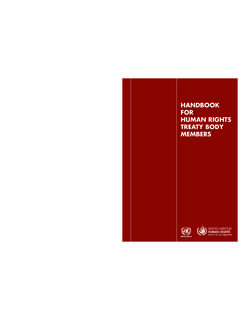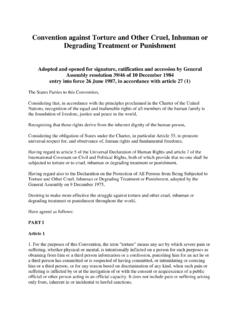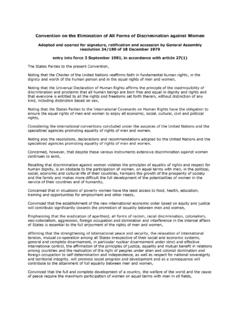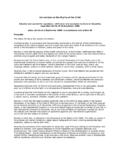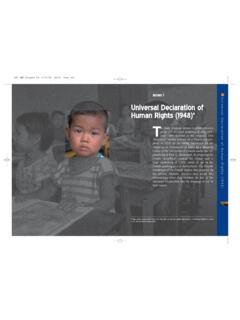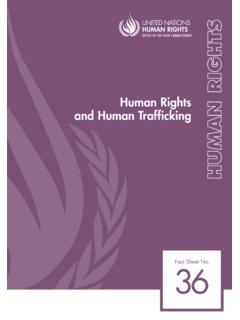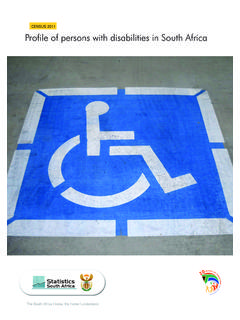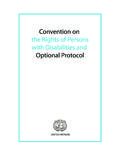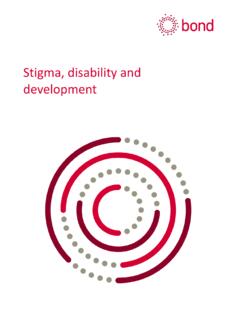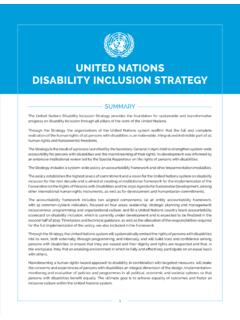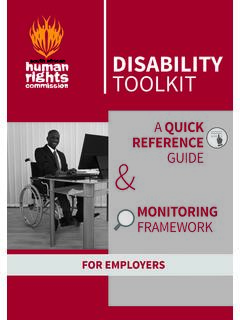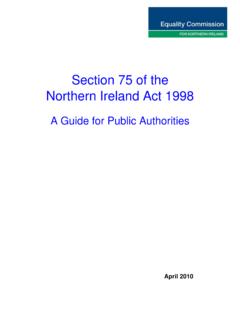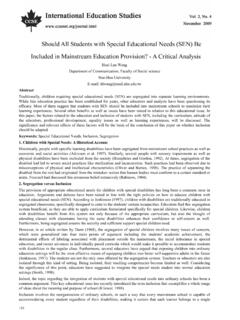Transcription of Human Rights and Disability - OHCHR
1 Human Rights and Disability The current use and future potential of United Nations Human Rights instruments in the context of Disability Gerard Quinn and Theresia Degener with Anna Bruce, Christine Burke, Dr. Joshua Castellino, Padraic Kenna, Dr. Ursula Kilkelly, Shivaun Quinlivan United Nations New York and Geneva, 2002. ii _____ Contents NOTE. Symbols of United Nations document are composed of capital letters combined with figures. Mention of such a symbol indicates a reference to a United Nations document. The views expressed in this publication are those of the authors and do not necessarily reflect the views of the Office of the United Nations High Commissioner on Human Rights . The designations employed and the presentation of the material in this publication do not imply the expression of any opinion whatsoever on the part of the United Nations Secretariat concerning the legal status of any country, territory, city or area, or of its authorities, or concerning the delimitation of its frontiers or boundaries.
2 Nor does the term national institution in any way imply conformity with the Principles relating to the status of national institutions (General Assembly resolution 48/134 of 20. December 1993, annex). HR/PUB/02/1. Copyright United Nations 2002. All Rights reserved. The contents of this publication may be freely quoted or reproduced or stored in a retrieval system for non-commercial purposes, provided that credit is given and a copy of the publication containing the reprinted material is sent to the Office of the High Commissioner for Human Rights , Palais des Nations, CH- 1211 Geneva 10, Switzerland. No part of this publication may be reproduced, stored in a retrieval system, or transmitted in any form without the prior permission of the copyright owner if the purpose relates to profit-making ventures. The licensing of Rights for commercial purposes is encouraged by the United Nations.
3 Iv _____ Contents Contents Page Note on contributors vii Foreword ix Acknowledgements x Executive summary 1. Part 1. Background: The shift to a Human Rights framework of reference Chapter 1 The moral authority for change: Human Rights values and the worldwide process of Disability reform 13. Human values the Human being as subject and not object 14. From values to Rights : a system of freedom built on Human values 19. The core problem: the "invisibility" of people with disabilities in the system of freedom 19. Human Rights as a visibility project in the context of Disability 26. Chapter 2 The application of moral authority: the shift to the Human Rights perspective on Disability through United Nations soft law 29. Early United Nations General Assembly resolutions on Disability 29. The emergence of the Rights model in the 1980s: the World Programme of Action (1982) 30.
4 Influential United Nations studies and guidelines 33. The United Nations Standard Rules on the Equalization of Opportunities for Persons with Disabilities (1993) 34. World conferences and Disability 38. United Nations Commission on Human Rights resolutions and Disability 40. United Nations expert seminars on Disability 42. General Assembly resolution on a convention to promote and protect the Rights and dignity of persons with disabilities 45. Conclusions 46. Chapter 3 Building bridges from soft law to hard law : the relevance of the United Nations Human Rights instruments to Disability 47. The United Nations Human Rights treaty system 47. Navigating the United Nations Human Rights treaty system 49. Part 2. Evaluation of the current use of the United Nations Human Rights instruments in the context of Disability Chapter 4 Disability and freedom: the International Covenant on Civil and Political Rights (ICCPR) 53.
5 The relevance of civil and political Rights to Disability 53. Enforcement and interpretation of the ICCPR in the context of Disability 59. Disability as a Human Rights issue in the complaints procedures under the first Optional Protocol to the ICCPR 72. Contents _____ v Conclusions on the ICCPR and Disability 75. Chapter 5 Disability and social justice: the International Covenant on Economic, Social and Cultural Rights 79. An overview of the International Covenant on Economic, Social and Cultural Rights 80. The general application of the ICESCR in the context of persons with a Disability 82. The relevance of specific ICESCR Rights in the context of Disability 88. Case studies on the current use of the ICESCR in the context of Disability 110. Conclusions on the ICESCR and Disability 130. Chapter 6 The integrity of the person: the Convention against Torture and Other Cruel, Inhuman or Degrading Treatment or Punishment and Disability 133.
6 An overview of the Convention against Torture and Other Cruel, Inhuman or Degrading Treatment or Punishment 133. The general relevance of Convention norms in the context of Disability 148. Case studies on the operation of the Convention in the context of Disability 151. Conclusions on CAT and Disability 163. Chapter 7 Gender and Disability : the Convention on the Elimination of all Forms of Discrimination against Women 165. Introduction to CEDAW 165. The general application of CEDAW norms in the context of Disability 172. Case studies on the current use of CEDAW in the context of Disability 178. Conclusions and future perspectives on CEDAW 188. Chapter 8 Disability and children: the Convention on the Rights of the Child (CRC) 191. Background to the Convention 191. The relevance of the CRC norms in the context of Disability 192.
7 Implementation of the Convention 200. Case studies on the current operation of the CRC in the context of children with disabilities 208. The increasing prominence of the Disability perspective in the CRC Committee 216. Conclusions on the CRC and Disability 226. Chapter 9 Disability and racial discrimination: the International Convention on the Elimination of All Forms of Racial Discrimination (CERD) 229. Background to the Convention 229. The Convention enforcement machinery 231. Relevance of ICERD norms in the context of Disability 233. Case studies on State party reports with a Disability dimension 239. Conclusions on CERD and Disability 240. Part 3. Options for the future: towards maximizing the potential of the United Nations Human Rights instruments in the context of Disability Chapter 10 Civil society: current use of the United Nations Human Rights system and future choices 243.
8 Part I: Organizational details 245. Part II: Self-understanding of Disability NGOs as Human Rights defenders (questions 1-6) 246. Part III: Self-evaluation of Human Rights capacities (questions 7-18) 249. vi _____ Contents Part IV: Current levels of DPO/INGO engagement with the United Nations Human Rights machinery 256. Part IV: Outcome of engagement with the Human Rights treaty monitoring bodies 263. Part VI: The future 268. Conclusions on the NGO questionnaire 270. Chapter 11 National Human Rights institutions catalysts for change 273. Level of Disability awareness (questions 1-3) 274. The status of Disability Rights on the agenda of national institutions (questions 4-7) 275. The Disability Rights record of national institutions (questions 8-11) 277. Litigation on Disability Rights 279. Education and capacity-building (questions 15 and 16) 280.
9 Disability and the law reform process (questions 17 and 18) 282. Conclusions 284. Chapter 12 Recommendations: Making the United Nations Human Rights machinery work better in the context of disabiity 287. States parties towards a more sustained focus on persons with disabilities as the beneficiaries of the Human Rights treaties 287. Treaty monitoring bodies towards the mainstreaming of Disability 288. The Office of the High Commissioner for Human Rights advancing Disability as a Human Rights issue 288. United Nations Commission for Human Rights bringing Disability onto the agenda 290. National Human Rights institutions enabling reform to come about 290. Civil society Disability NGOs as Human Rights NGOs 290. Chapter 13 Expanding the system: the debate about a Disability -specific convention 293. Growing support for a thematic convention 293.
10 A thematic convention as a way of enhancing the visibility of people with disabilities in the Human Rights system 294. The practical benefits of a thematic convention 295. Dignity and equality as the key to the content of a thematic convention 296. The new freedom agenda and Disability : the interdependence of all Human Rights 296. A thematic convention as an aid to the mainstreaming of Disability in United Nations Human Rights instruments 297. The mutually reinforcing roles of a thematic convention and the United Nations Standard Rules 297. _____ vii Contributors Theresia Degener is a German lawyer and Law Professor specializing in Disability law. She holds an from the University of California (Berkeley) and has published extensively on Disability law. She is a Professor of Law at the University of Applied Sciences, Rheinland-Westfalen-Lippe, Bochum, Germany.
